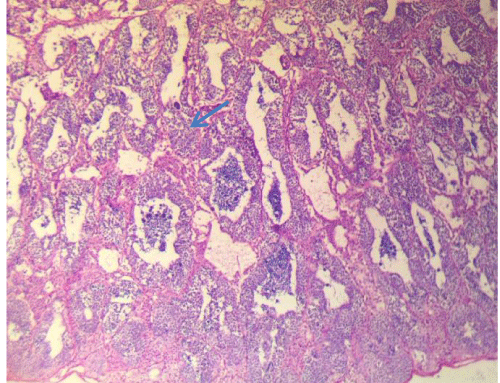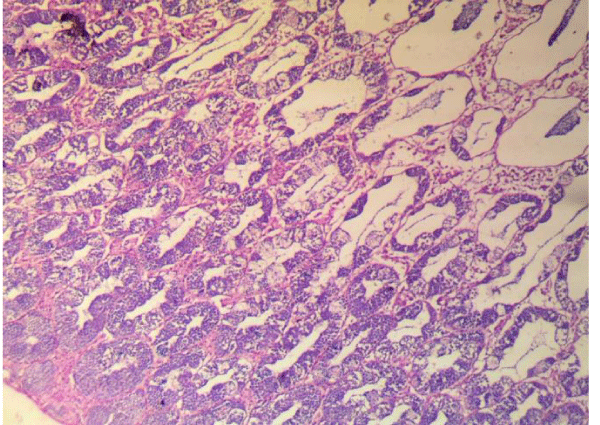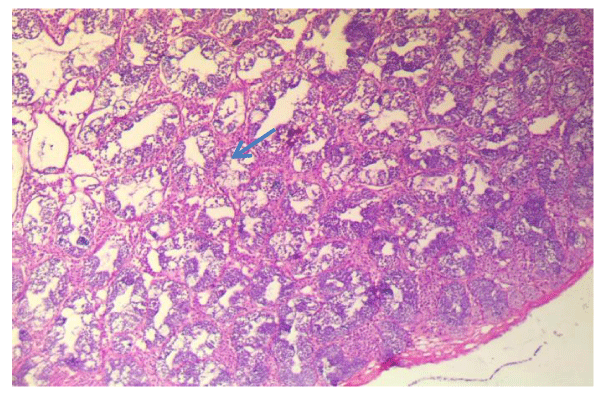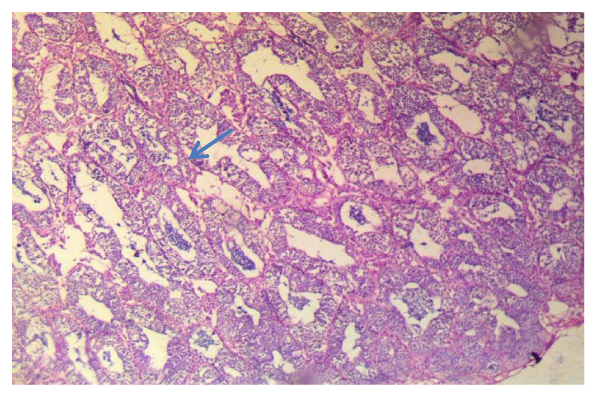International Journal of Aquaculture and Fishery Sciences
Effect of pawpaw seed meal using various inclusion level on the gonad structure of Oreochromis Niloticus (gift)
Udoh Brian Christopher1*, Nlewadim Anthony Ajuzieogu1, Umoh Imaobong A1 and Adelaja Olusumbo Adeolu2
2School of Economics, Finance and Banking, Universiti Utara Malaysia, 06010 Sintok Kedah Darul Aman, Malaysia
Cite this as
Christopher UB, Ajuzieogu NA, Umoh Imaobong A, Adeolu AO (2021) Effect of pawpaw seed meal using various inclusion level on the gonad structure of Oreochromis Niloticus (gift). Int J Aquac Fish Sci 7(3): 024-029. DOI: 10.17352/2455-8400.000069This study investigates the effect of pawpaw seed meal using various level of inclusion in regulating procreation in Oreochromis niloticus (gift strain) via morphology (percentage defective sperm cells) as well as gonads using biomarkers. The pawpaw seed powder was compounded to a 2mm tilapia feed at 35% crude protein at 2, 4 and 6g per kg diet. A total of twenty (20) fingerlings (10 males and 10 females) with average weight of 20g were randomly allotted in triplicate into concrete ponds (1m x 1m x 1 0.8m) of 600 litres capacity with control. The Tilapia fish was nourished at 4% body weight per day in dual portions at 09.00 – 09.30 hours and 17.00 – 17.30 hours. The experiment lasted for 60 days. Minor tissue damage (testes) was observed in fingerlings fed PSM at a level of 2h/kg while disintegration of a lot of cells occurred at increased dietary levels of PSM (4g and 6g per kg diet) which resulted to lack of spermatids and oocytes in the fish testes. Hence, it is useful in battling difficulties of over-population of tilapia in fish pond. Aside infertility, there were no observable contrary effect from pawpaw seeds consumption. Therefore, safe usage of 6 g PSM per kg diet for sixty (60) days is recommended for economic efficiency of fish farms. Further research is required on reducing the antinutrient substances (carpaine) in pawpaw seed so that it can be safely use as an additive in feeds.
Introduction
In order to ease the difficulties of malnutrition and starvation due to growing population, culturing of fish becomes an effective tool since fish is a valuable protein source alongside with several other qualities [1]. Fish contains wet body weight around 16-20% protein when related to 3.5% in milk, 6.6% in rice as well as wheat and 12% in egg. It has great nourishing values with good sense of taste and about 85-95% higher digestibility rate [2]. Fish protein signifies a vital nutritive element in some countries that are densely populated where entire levels of intake of protein are very little (Food and Agriculture Organization, (FAO, 2004). According to FAO [3], the rapidly developing sector which has surpassed population development is termed aquaculture.
Among the most significant set of cultured fish, tilapia is the second next to carp; in addition, it is the most extensively grown of any fish cultured on the earth [4]. Moreover, Burden [5] opines that Tilapia is cultured in no less than 85 nations on the globe. Tilapia is labelled ‘‘aquatic chicken’’ since it can be farmed commercially in an extensive variety of methods starting from the simple backyard methods to extremely intensive method or “factory farm” just like in poultry [6]. In majority of developing nations where tilapias are often cultured in cages, ponds, raceways, concrete tanks, as well as rice field are as a result of its characteristics which makes it appropriate for culturing [7].
Tilapia reproduces naturally in the wild; based on this feature, it influences overcrowding in the systems of fish ponds as well as reduced weight during harvest. Determination to alleviate this limitation include culturing of all-males which is mono-sex by means of exogenous hormone for sex reversal of sexually the same fish, predator usage, cage/tank culture, sterilization, high stocking density, sporadic or selective cropping, and usage of slow growing tilapia species [6-8]. Regardless of all the techniques examined, hormone initiation before population of monosex appears to be the most encouraging and satisfactory method [9]. Fish sex hormonal control is achieved by applying a precise hormone to the fry prior to occurrence of sexual differentiation. Tilapia gonadal differentiation seems to take place within 8-25 days’ post-hatch [10]. However, before usage, hormones have shortcomings of expensive technology, hatchery amenities as well as skilled workers are essential; likewise, hormones are costly and challenging to acquire [11].
On the other hand, there is need to investigate less expensive, suitable technology which does not pose a risk to human and environmental health in solving the difficulties of uncontrolled tilapia breeding. The botanical name of pawpaw is Carica papaya and it is one of the economically significant fruit trees in the Caricaceae family [6,12]. It contains folate, dietary fiber and vitamin A, C and E. It is very rich in antioxidant nutrients. It has been discovered that Pawpaw Seed Meal (PSM) consists of phytochemicals which holds boundless potential being sex reversal, likewise a procreative obstruction agent in culturing of fish. Phytochemicals are chemical compounds such as flavonoids, isoflavonoids and lignans amongst others which are natural steroid-like compounds derived from fruits, soy, cereals, tea and vegetables [13]. The usage of medicinal plants as enhancers of fertility as well as agents of sex reversal in fish has been gaining some awareness. A likely method to the usage of steroid hormones for sex reversal in tilapia might involve the use of plant extracts containing phytochemicals which are natural compounds characterized by estrogenic/androgenic activity. Moreover, with their effective immunostimulating and antioxidant properties, phytochemicals have been discovered to stimulate growth of fish [13]. Pawpaw (Carica papaya) has been used over the years to induce sterility in laboratory animals as well as therapeutic plants in rural communities to treat a lot of animal and human diseases [14,15]. Hence, this study was carried out to investigates the effects of the different inclusion levels of PSM on gonads of Genetically Improved Farmed Tilapia (GIFT).
Methodology
Study area
This study was conducted at Durante Fish Industries Limited, Old Niger West Building, Challenge, Ibadan; South Western Nigeria.
Preparation of experimental diets
Ripe fruits of pawpaw, Carica papaya (East West Seeds Cinta breed) of honey dew diversity was obtained free of charge from Durante fish industries farm and dissected in order to take out the seeds afterwards sundried then pulverized into finely particle sizes of less than 250 µm. The particles were preserved in a dry, sterile container; 2mm skretting tilapia fish feed pellets were obtained from Durante Fish Industries limited with nutrient composition of 35% crude protein as well as 18.5MJ gross energy per kg feed was formulated as prepared diet by adding 2.0 g, 4.0g, 6.0g dosage treatment of PSM separately to 1 kg of 2mm pellet skretting tilapia fish feed Table 1.
Source and collection of test fish
A total of two hundred and forty (240) fingerlings of Oreochromis niloticus (GIFT) strain was obtained from a single spawn and were collected from Durante Fish Industries Limited, Old Niger West Building, Challenge, Ibadan, South Western Nigeria. They were acclimatized for a period of 14 days in the concrete tanks and the fish were nourished with a profitable feed. After acclimatization, a total of 20 fish (10 males and 10 females) of average weight of 20g were stocked in 12 concrete tanks (1m x 1m x 1 0.8m) each and was supplied with fresh water of 600 litres capacity (temperature of water 27oC; hydrogen ion concentration (pH) 7.3; dissolved oxygen (DO) which ranges from 5.6-7.4 mg/l). Three (3) treatments was used and replicated three (3) times with control and replicates. The ponds were labelled control (0g), 2g, 4g and 6g respectively as used by Ugonna, et al. [16]. In addition, the fish was nourished at 4% body weight daily in two portions at 09.00 to 09.30hrs and 17.00 to 17.30hrs for period of 60 days; afterwards they were separated, grouped by sex then weighed.
Histopathological studies
Samples from testes were placed in formalin-saline solution in ratio 1:1 of 10% formalin plus 0.9% of sodium chloride for 24 hours. According to Luna [17], histological segments of 5μ diameter was prepared conforming to the standard procedures.
Statistical analysis
The collected data were accurately analysed via one-way Analysis of variance (ANOVA) as well as Duncan New Multiple Range (DNMR) post hoc test and mean differences at p <0.05 were significantly considered.
Results and discussions
Histology of testes [Magnification 100X]
Plate 1 shows the histological unit of the testes in Oreochromis.niloticus which was fed on control diet of 0g PSM per kg revealed typical testicular tissue, numerous seminiferous tubules containing fairly numerous amounts of spermatogenic cells as well as normal distribution of sperm cell. There is observation of visible lesions. In Plate 2, tilapia fed with 2g PSM per kg diet indicated that there were numerous seminiferous tubules which containing mildly exhausted quantities of spermatogenic cells. However, the nuclei of the sperm cells were bloated, bigger seminiferous tubules which contain discreetly depleted quantities of spermatogenic cells were identified in the fish fed with 4g PSM per kg diet and 6g PSM per kg diet in Plate 3 and 4.
Findings revealed that there is a severe mutilation which was executed on the tissues of the testes as the PSM inclusion levels increases. This results were confirmed by the work of Ekanem and Okoronkwo [18] who examined the use of seeds of Carica papaya as a productiveness control agent for the male of O. niloticus and follow similar concentrations (60g, 120g/kg). They observed inflamed sperm cells nuclei of the fish fed with little dose while the high dosage of seed of C. papaya led to sperm cells disintegration in addition to the formation of extra inflamed sperm cells nuclei. Presence of seminiferous tubules in testis O. niloticus fed C. papaya was recorded by Temitope and Oyedapo [19]. Furthermore, Temitope [20] and Temitope [21] observed similar histological effect in testis of Oreochromis niloticus which was treated with leaf meal of Hibiscus rosa sinensis as well as Aloe Vera Latex. Likewise, Feng [22] observed severe deterioration and self-digestion of seminiferous tubules after Oreochromis niloticus was fed with 2g of pawpaw seed powder/kg diet for the period of 15 and 30 days.
Sperm properties of Oreochromis niloticus
Table 2 and 3 indicated the results for sperm morphology and sperm progressive motility of Oreochromis niloticus fed various levels of inclusion of PSM. Concerning the various levels/weights, significant impacts were not observed on sperm motility, sperm count and sperm live/dead among all inclusion levels. Although, highest value of sperm motility, sperm count and sperm live/dead were recorded in “4g” PSM/kg diet while lowest values for sperm motility as well as sperm live/dead were reported in 0g while lowest value for sperm count was found in 2g respectively.
Likewise, plates 1-4 indicated the histopathological study of testes which showed numerous seminiferous tubules containing depleted amounts of spermatogenic cells. This could be the cause of low sperm count as well as the high proportion of flawed sperm cells observed in 2g-6g PSM compared to the control groups. Similarly, unspecified amount of toxic elements and unfavourable consequence of the plants were reported. Furthermore, Seigler, et al. [23] presented (2R)-prunasin a small quantity of sambunigrin which is the major cyanogenic glycoside in Carica papaya whereas Wickersham and Novak [24] stated that there is a substance named carpine which is toxic in nature which exist in pawpaw black seeds in trace amount. According to Nwaehujor, et al. [25], carpine has been discovered to lead to paralysis in large amounts, and also reduce pulse speed and weaken the nervous system. Moreover, Oyekunle and Omope [26] specified that the precise device through which the elements lessen sperm count is unidentified, nevertheless suggestions was made that the multiple papain might cross the barrier of the blood testes to apply dangerous impacts on seminiferous tubules control of the testes. A lot of studies have stated the existence of proteins in the sperm and semen. Additionally, prior study recounted the occurrence of serum proteins (lactoferrin, albumin) and glycoproteins (kinase, prostatic). The function of these proteins are to nurture the sperm cells. In 4g and 6g PSM, the amplified fraction of flawed sperm cell might be as a result of action of proteolytic of the proteases in pawpaw chymopapain and papain or in addition to the steroidal glycosides [27]. There is possibility that the semen proteins have been hydrolyzed by enzymes and compounds which makes them unobtainable for usage of the sperm cells, thus resulting to undernourishment plus flaws perceived in the cells.
Study by Bucholtz, et al. [28] opine that development of gonad is an incessant procedure, nonetheless particular histological features could be used during reproductive stage to categorize phases of gonadal growth. Therefore, all these histological modifications in ovary and testis of the trial fish are as a result of dietary levels of PSM. The current findings were in line to elucidate the achieved outcomes in both sexes (male as well as female) Nile tilapia [11,14,17]. This study used dosage of 2 to 8g per kg with period of exposure of 45 days which contrasts from the usage of prior studies. Likewise, Jegede [29] and Jegede [30] reported that Aloe vera latex as well as leaf of Hibiscus rosa-sinensis which are medicinal herbs cause related changes in the ovaries and testis of Nile tilapia; and likewise on laboratory animals like rats as well as rabbits [31,32].
Moreover, Farnsworth, et al. [33] opined that 5- hydroxytryptamine is a lively substance which is accountable for the anti-implantation result of seed of papaya in female. Also, papaya seeds extracts are competent of creating functional abnormalities of various mammalian organs/tissues plus systems possibly as a result of toxic impacts of benzyl-isothiocyanate. Additionally, Lucidi, et al. [34] stated that active growth of oocyte could influence steroidogenesis. Also, histological units which consist of atretic cavities might be as a result of decline in the level of oestrogen [35-39].
Findings in this study revealed that the acquired outcomes indicated that PSM high stages of 4 and 6 g per kg on extensive periods of exposure for 45 days in feeds of Nile tilapia fish showed positive influence to control the procreative procedure in Oreochromis niloticus which caused numerous histological fluctuations in the testis which abridged fertility in males Nile tilapia. However, Ugonna, et al. [16] reported that masculinization was highest among the fishes treated with 4g and 6g per kg which resulted in more than 85% males in these treatments. The inclusion level of PSM above 2g resulted in total non-appearance of female tilapia as well as percentage increase of sterile tilapia is encouraging for usage in commercial production.
Conclusion and recommendation
The study revealed that the damage which has been done on the tissues of the testes was negligible at decreased dietary level of PSM (2g per kg diet), and greater dietary levels of PSM (4g and 6g per kg diet) caused breakdown of a lot of cells and rendered the testes lack of spermatids. Based on this, dry seeds of pawpaw are recommended for use in controlling tilapia breeding. Histological examination of tilapia testes nourished with basal feed which is enhanced with PSM indicated that seeds of pawpaw are an efficient agent of inducing sterility as they were destructive to ovary and testes tissues.
Hence, it is suitable in contending difficulties of overpopulation of tilapia in ponds. Other than infertility, there were no observable opposing reactions from the pawpaw seeds consumption. Moreso, further research is required on reducing the antinutrient substances (carpaine) in pawpaw seed so that it can be safely use as an additive in feeds.
- Obiero K, Meulenbroek P, Drexler S, Dagne A, Akoll P, et al. (2019) The contribution of fish to food and nutrition security in Eatsern Africa: Emerging Trends and Future Outlooks. Sustainability 11: 1636. Link: https://bit.ly/3yExF88
- Anuar NS, Zahari SS, Taib IA, Rahman MT (2008) Effect of Green and Ripe Carica papaya Epicarp Extracts on Wound Healing and during Pregnancy. Food Chem Toxicol 46: 2384-2389. Link: https://bit.ly/3hOueoL
- Food and Agriculture Organization of the United Nation (2015) The post 2015 development agenda and millennium development goals. Fisheries, aquaculture, oceans and seas 1-3.
- FAO (2010) The State of World Fisheries and Aquaculture - 2010 (SOFIA). Rome. Link: https://bit.ly/2UUF97B
- Burden D (2014) Tilapia profile. International and special project, Extension value added agriculture and Agricultural Marketing Resource centre, Iowa State University 1-4.
- Magblenou LD, Mouhamadou ALY, Kantoussan J, Faye R, Yaghouba K (2019) Effects of varying dietary levels of Carica papaya seed meal powder (PSM) on growth and histology of gonads in Oreochromis niloticus larvae. Int J Biol Chem Sci 13: 624-633. Link: https://bit.ly/3iivvUc
- Fagbenro OA (2002) Tilapia: Fish for thought. Inaugural lecture series 32. The Federal University of Technology, Akure, Nigeria 77. Link: https://bit.ly/3rl3Mqb
- Beardmore JA (1996) Single sex super fish. Spore 64: 6-6.
- Pandian TJ, Varadaraj K (2005) Development of monosex female oreochromis mossambicus broodstock by integrating gynogenetic technique with endocrine sex reversal. J Exp Zool 255: 88-96. Link: https://bit.ly/3y2r4Dq
- Nakamura M, Iwahashi M (1982) Studies on the practical masculinization in Tilapia nilotica by the oral administration of androgen. Bulletin of the Japanese Society of Scientific Fisheries 48: 763–769. Link: https://bit.ly/3eABAKz
- Jegede T, Fagbenro O (2008) Histology of gonads in Oreochromis niloticus (Trewavas) fed pawpaw (Carica papaya) seed meal diets. Proceedings of the 8th International Symposium on Tilapia in Aquaculture 1135-1141. Link: https://bit.ly/3xSjGui
- Nwiloh BI, Nwinuka NM, Monanu MO (2009) The effect of aqueous extract of Carica papaya leaves on liver enzymes and blood cell counts of normal albino rats. Int J Biol Chem Sci 3: 561-566. Link: https://bit.ly/3Bh0kkM
- Chakraborty SB (2017) Evaluation of plants extracts on sex reversal and growth of Nile tilapia. Final Progress Report submitted to Department of Zoology, University of Calcutta. Link: https://bit.ly/3rlLBQQ
- Abbas HH, Abbas WT (2011) Assessment study on the use of pawpaw; Carica papaya seeds to control Oreochromis niloticus breeding. Pak J Biol Sci 14: 1117-1123. Link: https://bit.ly/3kyQh4w
- Dakpogan HB, Mensah S, Attindehou S, Chysostome C, Aboh A, et al. (2018) Anticoccidial activity of Carica papaya and Vernonia amygdalina extract. Int J Biol Chem Sci 12: 2101-2108. Link: https://bit.ly/3xPIlj7
- Ugonna BO, Solomon SG, Olufeagba SO, Okomoda VT (2018) Effect of Carica papaya seed meal on growth and as a natural sex-reversal agent for Oreochromis niloticus (Linnaeus, 1758). North American Journal of Aquaculture 80: 278-285.
- Luna LG (1992) Histopathological Methods and Color atlas of Special Stains and Tissue Artifacts. American Histolabs, Gaithersburg, MD. Link: https://bit.ly/3wTTvSF
- Ekanem SB, Okoronkwo TE (2003) Pawpaw seed as a fertility control agent on male Nile tilapia. NAGA. World Fish Centre Q 26: 8-10. Link: https://bit.ly/3xPkeRR
- Temitope J, Oyedapo F (2008) Histology of gonads in Tilapia zillii (Gervais) fed neem (Azadirachta indica) leaf meal diets. 8th International Symposium on Tilapia in Aquaculture 1129: 1134. Link: https://bit.ly/2Tnt7De
- Temitope J (2010) Control of reproduction in Oreochromis niloticus (Linnaeus 1758) using Hibiscus rosa-sinensis (Linn.) leaf meal as reproduction inhibitor. Journal of Agricultural Science 2: 149–154. Link: https://bit.ly/3rku9fB
- Temitope J (2011) Effects of Aloe vera (Liliaceae) on the gonad development in Nile tilapia, Oreochromis niloticus (Linnaeus 1758). Aqua Fish Collaborative Research Support Program 222-227. Link: https://bit.ly/3inRJEb
- Feng E (2011) Bitter gourd (Momordica charantia) is a cornucopia of health: a review of its credited antidiabetic, anti-HIV, and antitumor properties. Curr Mol Med 11: 417-436. Link: https://bit.ly/2VYBaHy
- Seigler DS, Pauli GF, Nahrstedt A, Leen R (2002) Cyanogenic allosides and glucosides from Passiflora edulis and Carica papaya. Phytochemistry 60: 873–882. Link: https://bit.ly/3xRE3rB
- Wickersham RM, Novak KK (Eds.) (2003) Drug Facts and Comparisons. Wolters Kluwer Health, Inc., St. Louis, MO.
- Nwaehujor OC, Ode OJ, Ekwere MR, Udegbunam RI (2014) Anti-fertility effects of fractions from Carica papaya (Pawpaw) Linn. methanol root extract in male Wistar rats. Arabian Journal of Chemistry 12: 1563-1568. Link: https://bit.ly/2UXOTxT
- Oyekunle OA, Omope MM (2010) Evaluation of andrological indices and testicular histology following chronic administration of aqueous extract of Carica papaya leaf in Wistar rat. Afr J Pharm Pharmacol 4: 252–255. Link: https://bit.ly/3ri8ncF
- Edwards JJ, Tollaksen SL, Andersom NG (1981) Proteins of human semen. A two dimensional mapping of human seminal fluid. Clin Chem 27: 1335–1340. Link: https://bit.ly/2VX8ajr
- Bucholtz RH, Tomkiewicz J, Dalskov J (2008) Manual to determine gonadal maturity of herring (Clupeaharengus L.). DTU Aqua-report 197-08, Charlottenlund: National Institute of Aquatic Resources 45. Link: https://bit.ly/3zgcYhZ
- Jegede T (2009) Effects of Aloe vera (Liliaceae) on the gonad development in Nile tilapia Oreochromis niloticus (Linnaeus 1758). Better science, better fish, better life, Proceedings of the Ninth International Symposium on Tilapia in Aquaculture. Shanghai Ocean University, Shanghai, China 22-24
- Jegede T (2010) Control of reproduction in Oreochromis niloticus (Linnaeus, 1758) using Hibiscus rosa-sinensis (Linn.) leaf meal as reproduction inhibitor. Journal of Agriculture Science 2: 149-154. Link: https://bit.ly/3rku9fB
- Lohiya NK, Pathak N, Mishra PK, Manivannan B (1999) Reversible contraception with chloroform extract of Carica papaya linn. seeds in male rabbits. Reprod Toxicol 13: 59–66. Link: https://bit.ly/3kxm4Tz
- Goyal S, Manivannan B, Ansari AS, Jain SC, Lohiya NK (2010) Safety evaluation of long term oral treatment of methanol sub-fraction of the seeds of Carica papaya as a male contraceptive in albino rats. J Ethnopharmacol 127: 286–291. Link: https://bit.ly/3hMFVMD
- Farnsworth NR, Bingel AS, Cordell AG, Crane AF, Fong HS (1975) Potential value of plants as source of raw antifertility agents. I. J Pharm Sci 64: 535-592. Link: https://bit.ly/2UReIQ2
- Lucidi P, Bemabo N, Turriani M, Mattioli M, Barboni B (2003) Cumulus steroido genesis is influenced by the degree of oocyte maturation. Reprod Biol Endocrinolol 1: 45-55. Link: https://bit.ly/3zf8OY2
- Khalil FF, Farrag FH, Mehrim AI, Rafaey MA (2014) Paw-paw (Carica papaya) seeds powder in Nile tilapia(Oreochromismossambicus) diets: 2 liver status, sexual hormones and histological structure of gonads. Egypt. Journal of Aquatic Biology and Fish 18: 97-113. Link: https://bit.ly/3imgUHu
- Adebiyi A, Adaikan PG, Prasad RNV (2003) Tocolytic and toxic activity of papaya seed extract on isolated rat uterus. Life Sci 74: 581–592. Link: https://bit.ly/3wP150Y
- Food and Agriculture Organization of the United Nation (2014) Food energy- Method of analysis and conversion factors. FAO Food and Nutrition 77: 73-78.
- Mair GC, Little DC (1991) Population control in farmed tilapia. NAGA, ICLARM. Quarterly 14: 8-13. Link: https://bit.ly/3ezstd1
- Pullin R (1985) Tilapia: Everyman’s fish. Biologist 32: 84–88.

Article Alerts
Subscribe to our articles alerts and stay tuned.
 This work is licensed under a Creative Commons Attribution 4.0 International License.
This work is licensed under a Creative Commons Attribution 4.0 International License.




 Save to Mendeley
Save to Mendeley
